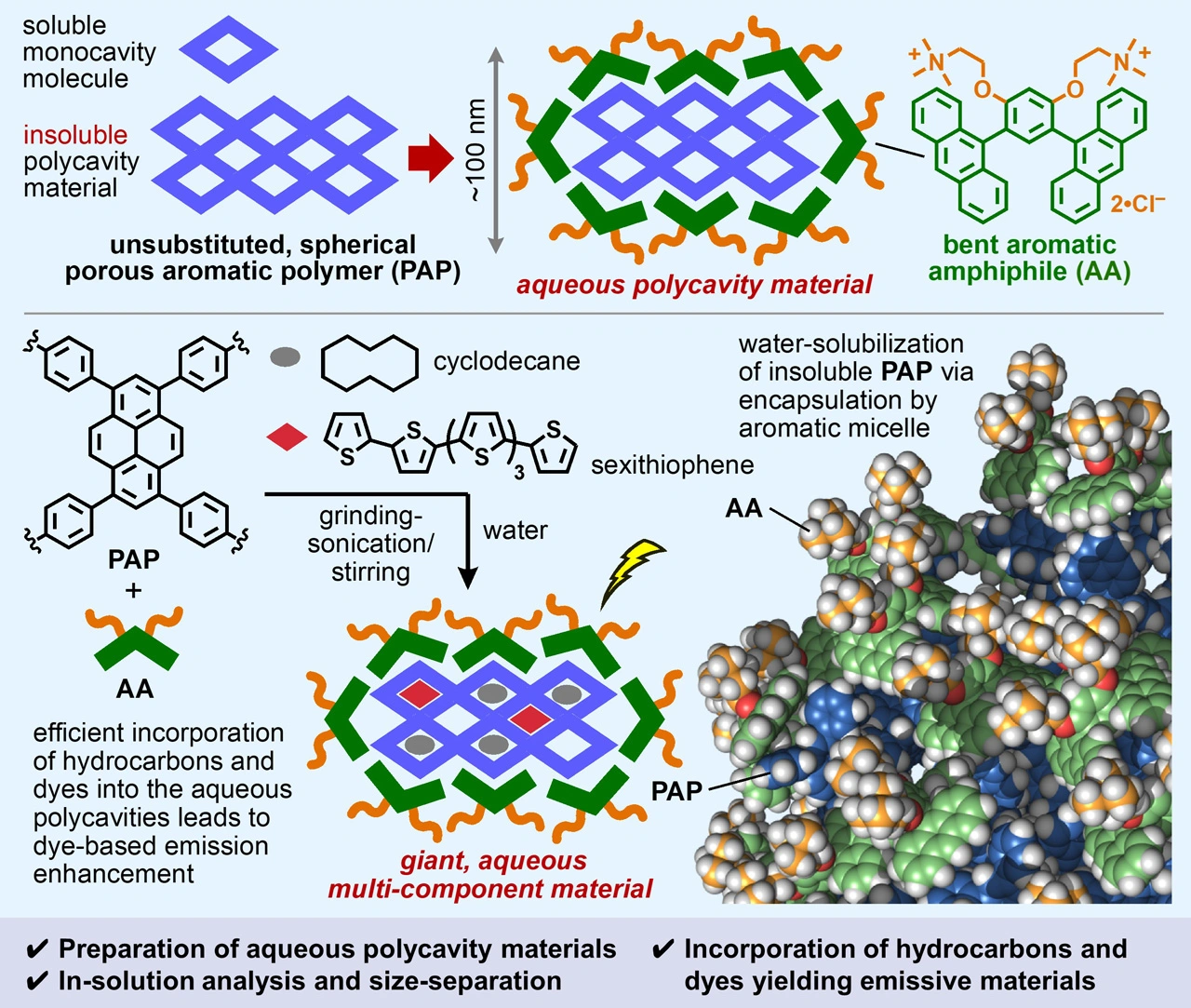How to Create Aqueous 100 nm-Sized Materials with Polycavities
Researchers at Science Tokyo have developed a method to dissolve previously insoluble porous aromatic polymers (PAPs) in water by encapsulating them in aromatic micelles. These 100 nm-sized particles, which normally function only in solid form, can now incorporate hydrocarbons and dyes in solution, forming unique multi-component materials. The technique uses a simple grinding and sonication process, and enables particle size control via centrifugation and filtration. Notably, the presence of hydrocarbons enhances the fluorescence of the embedded dyes up to ninefold. This breakthrough introduces a new class of water-soluble, polycavity materials with potential applications in sensing, storage, and catalysis—opening up new possibilities beyond conventional single-cavity molecular systems.
How to Create Aqueous 100 nm-Sized Materials with Polycavities

Aoyama et al. (2025) | Chem | 10.1016/j.chempr.2025.102616 (Figures are licensed under CC BY 4.0)
While molecules with a single cavity have been extensively studied in solution, the solution state functions of polycavity materials remain elusive owing to their synthetic inaccessibility. Porous aromatic polymers (PAPs) are synthesized in a single step and offer polymeric cavity frameworks with high stability, which are applicable to gas and molecule adsorption/separation only in the solid state. Due to their strong aggregation-derived insolubility, unsubstituted PAPs cannot be used in any solvent until now.
To move the functions of PAPs from the solid to the solution state, researchers from Science Tokyo's Laboratory for Chemistry and Life Science in Japan studied the solubilization of PAPs in water through encapsulation by aromatic micelles. Published in Chem (Cell Press) on June 02, Shinji Aoyama, Lorenzo Catti, and Michito Yoshizawa report that aromatic micelles, formed from bent aromatic amphiphiles (AA), are capable of solubilizing unsubstituted PAPs in water, with more than 7-times efficiency compared to conventional alkyl micelles. The solubilization was achieved using a simple grinding-sonication protocol. Detailed analyses in both solution and solid states revealed that the products exist as spherical particles with diameters of around 100 nm.
While PAPs are obtained as a complex mixture of various particle sizes during synthesis, the group demonstrated size-separation of the giant aqueous materials using a facile centrifugation-filtration protocol, yielding products with a highly uniform size-distribution. A regulated particle size is considered important for potential applications in advanced functional materials.
Importantly, PAPs within aromatic micelles effectively incorporated hydrocarbons (e.g., cyclodecane and toluene) in water. For example, stirring a mixture of an encapsulated pyrene-benzene-based PAP (PBP) with cyclodecane gave rise to a three-component material, including a huge amount of the cyclodecane molecules in the semi-rigid polycavities, showing a 9-fold enhanced polymer emission.
“Besides hydrocarbons, fluorescent organic dyes could likewise be incorporated into the polycavity yielding aqueous three-component materials with red and green emission properties. Fluorescent analysis indicated that the incorporated dyes are present in a highly dispersed fashion, unlike in related monocavity systems. Introducing completely insoluble dyes like sexithiophene into the polycavities of insoluble materials using the present method will allow the preparation of previously inaccessible multi-component materials”, says Dr. Catti.
Finally, the group revealed that the emission of the incorporated dyes can be significantly enhanced through co-incorporation of the hydrocarbons into the dye-doped polycavity in water. For instance, addition of cyclodecane induced a 9-fold increase in dye-based red emission, likely due to the reduction of dye-to-polymer and dye-to-dye interactions by the bulky additives. It is noteworthy that the selective formation of four-component materials such as the present one is extremely rare.
The team concludes “encapsulation of 100 nm-sized porous aromatic polymers by aromatic micelles provides a new type of giant polycavity material with excellent incorporation functions in water, completely different from monocavity molecules reported previously, enabling the preparation of rare multi-component materials. The herein reported method will also be applicable to inorganic and organic-inorganic porous solids, paving the way for superior materials tailored for storage, sensing, and catalytic applications in water.”
Reference
- Authors:
- Shinji Aoyama, Lorenzo Catti*, and Michito Yoshizawa*
- Title:
- Aqueous Polycavity Hosts Composed of Porous Aromatic Polymers within Aromatic Micelles
- Journal:
- Chem (Cell Press)
- DOI:
- 10.1016/j.chempr.2025.102616 (open access)
- Affiliations:
- Laboratory for Chemistry and Life Science, Institute of Integrated Research,
Institute of Science Tokyo
Related articles
Further Information
Assistant Professor Lorenzo Catti
Laboratory for Chemistry and Life Science, Institute of Integrated Research, Institute of Science Tokyo
Professor Michito Yoshizawa
Laboratory for Chemistry and Life Science, Institute of Integrated Research, Institute of Science Tokyo
Contact
Public Relations Division, Institute of Science Tokyo
- Tel
- +81-3-5734-2975
- media@adm.isct.ac.jp